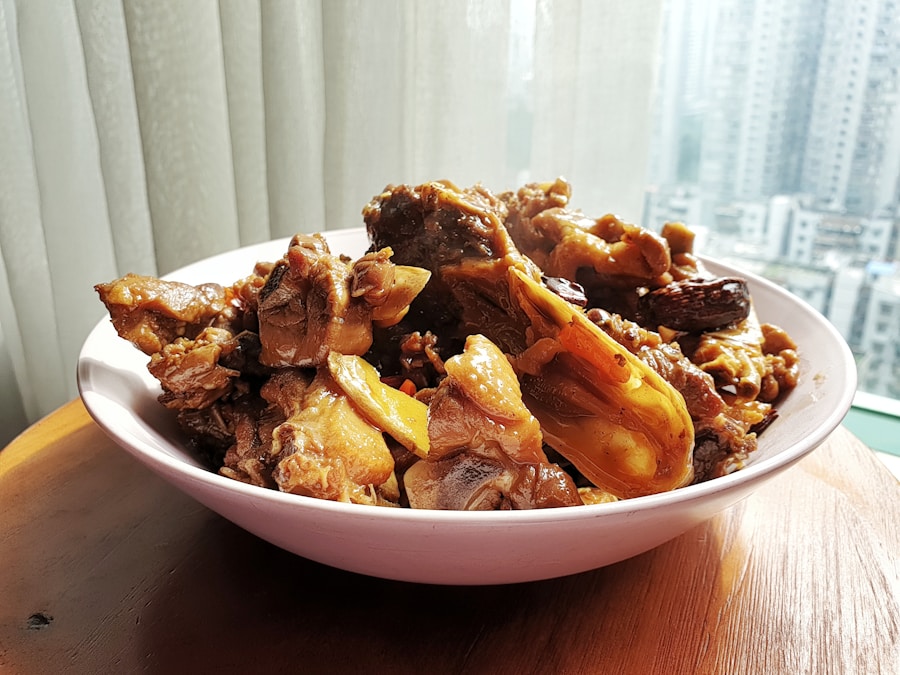Download links
How to install The Ultimate Guide to Perfect Adobo APK?
1. Tap the downloaded The Ultimate Guide to Perfect Adobo APK file.
2. Touch install.
3. Follow the steps on the screen.
Description
Adobo, a dish that has become synonymous with Filipino cuisine, boasts a rich and complex history that reflects the diverse cultural influences that have shaped the Philippines over centuries. The term “adobo” is derived from the Spanish word “adobar,” which means “to marinate.” This connection to Spanish colonialism is significant, as it was during the 16th century that the Spanish introduced their culinary practices to the archipelago. However, the roots of adobo extend far deeper into pre-colonial Filipino cooking traditions, where indigenous methods of preserving meat through vinegar and spices were already in practice.
This melding of indigenous techniques with Spanish influences resulted in a dish that is both uniquely Filipino and a testament to the country’s colonial past. The evolution of adobo is not merely a tale of cultural exchange; it also reflects the adaptability of Filipino cuisine. Different regions of the Philippines have developed their own variations of adobo, influenced by local ingredients and culinary practices.
For instance, in the Visayas region, adobo may incorporate coconut milk, lending a creamy texture and sweetness to the dish.
Key Takeaways
- Adobo has a long history dating back to the Spanish colonization of the Philippines, where it was originally used as a method of preserving meat.
- The key ingredients in adobo are vinegar, soy sauce, garlic, and bay leaves, but there are many variations that include different proteins and additional spices.
- The best cooking technique for adobo is to marinate the meat in the sauce for at least 30 minutes before simmering it in a pot until tender.
- Achieving the perfect balance of flavors in adobo requires adjusting the amount of vinegar, soy sauce, and sugar to suit your personal taste preferences.
- Adobo can be served with steamed rice, pickled vegetables, and a side of fresh fruit, and pairs well with a cold beer or a glass of white wine.
Ingredients and Variations
At its core, adobo is characterized by a few key ingredients: meat (commonly chicken or pork), vinegar, soy sauce, garlic, bay leaves, and black peppercorns. The vinegar serves as both a preservative and a flavor enhancer, while soy sauce adds depth and umami. Garlic is essential for its aromatic qualities, and bay leaves contribute a subtle herbal note that rounds out the dish.
The choice of meat can vary widely; while chicken and pork are the most popular, beef, duck, and even seafood can be used, showcasing the versatility of this dish. Variations of adobo are as diverse as the islands themselves. For example, adobo sa gata incorporates coconut milk, resulting in a richer and creamier sauce that contrasts beautifully with the tangy vinegar.
In contrast, adobo puti uses only vinegar and no soy sauce, resulting in a lighter-colored dish that emphasizes the sharpness of the vinegar. Another notable variation is adobong sitaw, which includes long green beans as a primary ingredient alongside the meat. This not only adds texture but also introduces a fresh element to the dish.
Each variation tells a story about local ingredients and preferences, making adobo a canvas for culinary creativity.
The Best Cooking Techniques

Cooking adobo is an art that requires attention to detail and an understanding of how flavors develop over time. The traditional method begins with marinating the meat in a mixture of vinegar, soy sauce, garlic, bay leaves, and peppercorns. This step is crucial as it allows the meat to absorb the flavors before cooking begins.
Marinating for at least an hour is recommended, but for optimal results, letting it sit overnight in the refrigerator can yield even more flavorful results. Once marinated, the cooking process typically involves browning the meat in oil before adding the marinade. This step not only enhances the flavor through caramelization but also adds a layer of complexity to the dish.
After browning, the marinade is added back into the pot along with water if necessary, and the mixture is simmered until the meat is tender. The slow cooking process allows the flavors to meld together beautifully. Some cooks prefer to finish their adobo by reducing the sauce until it thickens, creating a glossy coating on the meat that intensifies its flavor.
Others may opt for a more soupy version, perfect for serving over rice.
Tips for Achieving the Perfect Balance of Flavors
| Flavor | Percentage |
|---|---|
| Sweet | 30% |
| Salty | 20% |
| Sour | 15% |
| Bitter | 10% |
| Umami | 10% |
| Spicy | 15% |
Achieving the perfect balance of flavors in adobo requires an understanding of how each ingredient interacts with one another. One key tip is to taste as you go; this allows you to adjust the levels of vinegar and soy sauce according to your personal preference. If you find your adobo too tangy, adding a touch of sugar can help balance out the acidity without overpowering the dish.
Conversely, if you prefer a more pronounced salty flavor, increasing the soy sauce can enhance that aspect. Another important consideration is the quality of your ingredients. Using high-quality vinegar—such as cane vinegar or coconut vinegar—can significantly elevate your adobo’s flavor profile.
These vinegars have distinct characteristics that can add depth to your dish. Additionally, fresh garlic and whole peppercorns will provide more robust flavors compared to their dried counterparts. Finally, allowing your adobo to rest after cooking can also improve its taste; letting it sit for several hours or overnight allows the flavors to deepen and develop further.
Serving Suggestions and Pairings
Adobo is often served with steamed white rice, which acts as a neutral base that absorbs the rich flavors of the sauce. The combination of tender meat and savory sauce over rice creates a comforting meal that is beloved by many Filipinos. For those looking to elevate their dining experience further, consider serving adobo alongside pickled vegetables or atchara (pickled papaya).
The acidity from these accompaniments can cut through the richness of the dish and provide a refreshing contrast. In addition to rice, adobo pairs well with various side dishes that complement its flavors. For instance, sautéed greens such as bok choy or spinach can add a nutritious element to your meal while balancing out the heaviness of the meat.
Some people enjoy serving adobo with fried plantains or crispy fried potatoes for added texture and sweetness. Furthermore, pairing adobo with a light beer or a refreshing iced tea can enhance your dining experience by providing a palate-cleansing effect between bites.
How to Store and Reheat Adobo for Maximum Flavor

Storing adobo properly is essential for maintaining its flavor and texture over time. After cooking, allow your adobo to cool completely before transferring it to an airtight container. It can be stored in the refrigerator for up to five days or frozen for longer preservation—up to three months without significant loss of quality.
When freezing, consider portioning it into smaller containers for easy reheating later on. Reheating adobo requires some care to ensure that it retains its delicious flavors. The best method is to gently reheat it on the stovetop over low heat, adding a splash of water or broth if necessary to prevent it from drying out.
Stir occasionally to ensure even heating and prevent sticking. If you’re reheating from frozen, it’s advisable to thaw it in the refrigerator overnight before reheating; this helps maintain its texture and flavor integrity. Some enthusiasts even argue that adobo tastes better after sitting for a day or two, as this resting period allows flavors to meld further—making it an ideal candidate for meal prep or leftovers.
In summary, adobo is not just a dish; it is a cultural artifact that embodies centuries of history and culinary evolution in the Philippines. Its ingredients are simple yet versatile, allowing for countless variations that reflect regional preferences and personal tastes. Mastering cooking techniques and understanding how to balance flavors are crucial steps in creating an authentic adobo experience.
Whether served with rice or paired with complementary sides, adobo remains a beloved staple that continues to bring families together around the dining table. Proper storage and reheating techniques ensure that this iconic dish can be enjoyed long after it has been made, allowing its rich flavors to shine through every time it is served.
FAQs
What is Adobo?
Adobo is a popular Filipino dish that involves marinating meat, seafood, or vegetables in a mixture of vinegar, soy sauce, garlic, and other seasonings, and then simmering it until tender.
What are the main ingredients in Adobo?
The main ingredients in Adobo typically include vinegar, soy sauce, garlic, bay leaves, and black peppercorns. The dish can be made with various proteins such as chicken, pork, beef, or seafood.
How is Adobo cooked?
Adobo is typically cooked by marinating the protein in the vinegar and soy sauce mixture for a period of time, and then simmering it in the same marinade until the meat is tender and the flavors have melded together.
What is the origin of Adobo?
Adobo is a traditional Filipino dish that has its roots in Spanish cuisine. The cooking method of marinating and stewing meat in vinegar and spices was introduced by the Spanish during their colonization of the Philippines.
What are the variations of Adobo?
There are many regional and personal variations of Adobo in the Philippines. Some variations include using coconut milk, adding sugar for a sweeter flavor, or using different types of protein such as fish or vegetables.





